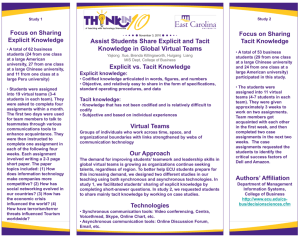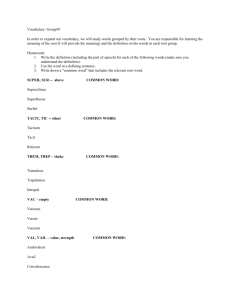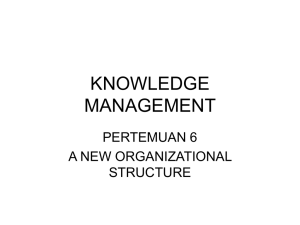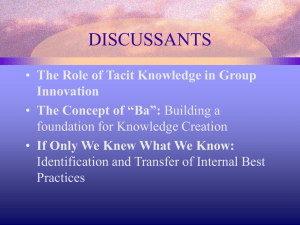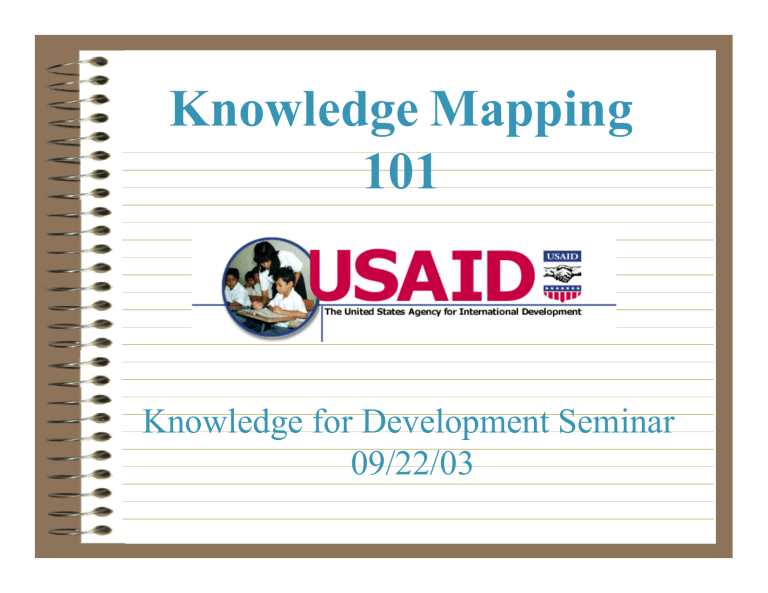
Knowledge Mapping 101 Knowledge for Development Seminar 09/22/03 Knowledge Mapping Agenda • Knowledge for Development – What is Knowledge Management? • Knowledge Mapping – Mapping Overview • Definitions • Why • How Leadership Share Create Apply Measurement Organizational Knowledge Identify -needed by Processes -supporting Strategies Organize – USAID Examples – Discussion Knowledge Management Enablers Knowledge Management Process Collect Adapt Technology Culture Knowledge Management Discussion – What do we mean by “management”? – What is “knowledge”? Know Who, Know How, and Know What Knowledge experience Information context Data fact Tacit Explicit Conversion of knowledge between tacit and explicit forms An iterative process Tacit Tacit Know-how, Know-how,expertise, expertise, improvisation, improvisation,instinctive, instinctive, automatic automatic Culture, Culture,roles, roles,history, history, ritual, ritual,workflows workflows Job Jobaid, aid,technical, technical, notes/journals notes/journals Documents, Documents, Databases, Databases,strategies/ strategies/ plans, plans,directories, directories, processes processes Explicit Explicit Individual Individual Collective Collective Characteristics of Knowledge • • • • • • • Created by anyone Distributed cheaply Increases when shared Transmitted in networks Guided by vision Unique for individuals Infinite resource Knowledge Management Alan Marwick, IBM Research Division • Knowledge – includes both the experience and understanding of the people in the organization and the information artifacts, such as documents and reports, available within the organization and in the world outside • Knowledge Management – name given to the set of systematic and disciplined actions that an organization can take to obtain greatest value from the knowledge available to it Knowledge Management • APQC Definition – Connecting people to the best practices, knowledge, and expertise they need to create value. From its 4th Annual Conference on Knowledge Management held in Washington, D.C. in May 2002, the American Productivity and Quality Association (APQC) • USAID Working Definition – Systematic approaches to help information and knowledge emerge and flow to the right people at the right time to create value. Knowledge Management Processes and Enablers Collect Adapt Identify Organize Information Process 1 Information Process 2 Information Process 3 Information Create Apply Share Culture Leadership Measurement Technology Knowledge Management Framework -American Productivity Quality Center Leadership Share Create Apply Measurement Organize Organizational Knowledge -needed by Processes -supporting Strategies Adapt Technology KM Enablers KM Processes Identify Collect Culture Knowledge Management • Questions • Suggestions • Concerns Systematic approaches to help information and knowledge emerge and flow to the right people at the right time to create value. Knowledge Mapping Overview • Some Definitions – What is Knowledge Mapping? – What it is not • Why Knowledge Mapping? • How to Map Leadership Share Create Apply Measurement Organizational Knowledge Identify -needed by Processes -supporting Strategies Organize Collect Adapt Technology Knowledge Management Enablers Knowledge Management Process Culture Knowledge Mapping Definitions • What is Knowledge Mapping ? – Knowledge mapping is a process of surveying, assessing and linking the information, knowledge, competencies and proficiencies held by individuals and groups within an organization (Dr Ann Hylton, KeKma-Training 2002) Knowledge Mapping Definitions – An ongoing quest within an organization (including its supply and customer chain) to: • help discover the location, ownership, value and use of knowledge artifacts, • learn the roles and expertise of people, • identify constraints to the flow of knowledge, and • highlight opportunities to leverage existing knowledge. – It illustrates or "maps" how knowledge flows throughout an organization. (D. Grey, 2002 Smith Weaver Smith Inc) What is Knowledge Mapping? • Knowledge mapping is a process by which organizations can identify and categorize knowledge assets within their organization – people, processes, content, and technology. • It allows an organization to fully leverage the existing expertise resident in the company, as well as identify barriers and constraints to fulfilling strategic goals and objectives. • It is constructing a roadmap to locate the information needed to make the best use of resources, independent of source or form. (W. Vestal, APQC, 2002) What is Knowledge Mapping ? – A Knowledge Map describes what knowledge is used in a process, and how it flows around the process. It is the basis for determining knowledge commonality, or areas where similar knowledge is used across multiple processes. – Fundamentally, a process knowledge map contains information about the organization’s knowledge. It describes who has what knowledge (tacit), where the knowledge resides (infrastructure), and how the knowledge is transferred or disseminated (social). (IBM Global Services - Technique Paper, 2000) Tactical Strategic Knowledge Mapping: Where to focus? • Enterprise-level — Strategic business, technical, market knowledge — Determine the organization’s “bench strength” — Identify areas to focus KM efforts • Cross-functional between divisions/business groups — Operational assessment of working knowledge • Working group/process — Tactical and operational knowledge applied to process excellence, innovation, customer relationship Types of Knowledge Maps Enterprise Knowledge Map Cross-Functional Knowledge Map Process Knowledge Map What it’s NOT... – Knowledge Inventory – Knowledge Audit – Search Tool • Autonomy • VisuAlert Not a ‘visualization’ What it’s NOT... • A KM assessment of how well a KM initiative is performing • An assessment of how well a Community of Practice is performing • Either explicit knowledge OR tacit knowledge; both are necessary • A solution • A method to identify projects • A way to create a KM strategy Process Knowledge Mapping – A method of analysis to define the knowledge needed and the knowledge available to support a business process. – Knowledge Mapping identifies the: • explicit knowledge (knowledge artifacts) • tacit knowledge (undocumented information, expertise in people’s heads) • infrastructure (where does it the reside) • organization ( who and where are the people) – In context of a specific business process Why Map? • Organizations use knowledge maps for a number of different reasons. Some organizations compile company locators to find internal and external resources. • Others use them to identify knowledge sharing opportunities or knowledge barriers within crossfunctional work groups. • Many companies use knowledge mapping before developing formal communities of practice or After-Action Reviews. Uses of Knowledge Maps • Compile company locators – internal and external resources - KM Yellow Pages • Identify opportunities to reuse information • Locate naturally-occurring knowledge stewards • Identify knowledge dependencies within crossfunctional work groups • Categorize value-added information resident within your organization • Identify knowledge sharing opportunities • Precursor to developing formal communities of practice • Create a knowledge tool that helps users find what they need (e.g. Agricultural Trade Programming Tool). Process Knowledge Mapping Answers Key Questions • At all levels, the knowledge map provides an assessment of existing or required knowledge and information in the following categories: – What knowledge is needed? – Who has this knowledge? – Where does this knowledge reside? – Is the knowledge tacit or explicit? – Is the knowledge routine or non-routine? – What issues does it address? What a Knowledge Map Reveals about an Organization • Identifies the core and contextual knowledge inside of an organization • How information and knowledge flows • What individual knowledge or expertise is critical to a process or focus area When To Map Organizations should not design a KM approach without first mapping their knowledge. Within the context of APQC’s Road Map to Knowledge Management, mapping knowledge is recommended in stage 2 (develop a strategy) or stage 3 (design and launch a knowledge management initiative). How To Map... Sample Knowledge Map: (1) (2) (3) (N) Process Step Determine test site concept regarding which features to address Establish test site scheduling Identify test site coordinator Etc.... Objective of Step Create list of expected problems and test structures to address Make sure it's ready so it is useful to product Assign responsibility to ensure test site design is complete Nothing Note: no learning captured and applied re. Experiences Note: need to define roles and responsibilities Relationship between managers and prospective test site coordinators Etc... Infrastructure Social Capital Content Databases with info of previous projects (product and failure test results) Design manuals Test site documents Look at previous schedules Project plan (top down req.) Test site schedule Process roadmap Discussion among process design people Connecting with previous test site designers (all previous experience related) Discussions with designers (knowledge of work behind design-how long it takes) Discussions with test site coordinators regarding timing Knowledge of previous test site designers Objectives of design Experience re. What worked well and potential problems ·Knowledge of how long steps take Knowledge of process and design re. what's possible Knowing how long it will really take in mask house Mgr's knowledge of people's capabilities Knowledge of someone's experience (someone who is systematic, can drive things upward, available, willing) Etc... Etc... Etc... Process Knowledge Mapping Process knowledge mapping analyzes a business process or method to identify: – Decision milestones (where knowledge is needed) – Knowledge requirements (what knowledge is needed) – Routes for access and retrieval of knowledge (through people and technology) – Gaps between required skills and current skills What do you need to know? Where does the knowledge come from? Who owns it? What knowledge, tools and templates exist today? What knowledge, tools and templates should be created? What barriers or issues exist ? Tactical Steps • Select the process/focus area (scope) • Identify the key business value of mapping the knowledge – who will use it? • Map the process(es) – – – – Determine routine/non-routine tasks Identify key decision points, hand-offs Locate owners of, and stakeholders in high-value processes Interview--follow the knowledge pathways through the organization – Inventory types of knowledge utilized and needed – Identify gaps, lack of connectivity, and information overload – Develop plan for collecting, reviewing, validating, storing and sharing knowledge and information • Map the knowledge against the process, using the template Knowledge Mapping Matrix What knowledge is needed? Who has it? Who needs it? Where is it? Is it tacit or explicit? Is it routine or nonroutine? What issue(s) does it address? (W. Vestal, APQC, 2002) Knowledge Mapping Steps 1) Review critical processes 2) Identify individual process steps within each process 3) Identify the knowledge required to fulfill the purpose of each process step Determine the knowledge required by brainstorming, or conduct interviews with the process owners. Categorize the knowledge Content (Explicit, Tacit, Embedded), the Social capital ( trust, interpersonal relationships, cultural norms) and Infrastructure ( processes, tools, roles & responsibilities, incentives). 4) Identify the knowledge generated for each process step 5) Create measurement criteria for each critical process step 6) Analyze the process maps (knowledge quality, knowledge sharing, ease of access, etc.) Provide Answers to the Following Questions: – What do you need to (1) know? – Where does the knowledge come from? – Who owns it? – What knowledge,tools and templates exist today? – What knowledge,tools and templates should be created? – What barriers or issues exist ? (2) (3) (n) Process Step Conduct design session Document product gap Develop prototype Etc… Objective of Step Gather requirements for COTS software Clarify requirements not met by package Create working model for reqs verification Etc… Methods and Tools Database Vendor Supplied Methods Vendor Supplied Tools Etc… Deliverables Database Methods and Tools Database Project Mgmt Guidelines Deliverables Database Discussion among functional consultants Discussion with vendor Relationship between vendor rep and tech consultants Etc… Knowledge of developers skills Knowledge of vendor’s tools Etc… Knowledge of package capabilities Experience with functional reqs Infrastructure Social Capital Connecting with SME’s Tacit Knowledge Knowledge of previous design sessions Estimating experience Discussion with Technical Consultants Analyze the process maps Review completed process maps; for each process step, review the knowledge resources and determine: • Do we leverage this today? • Is the knowledge available and accessible to everyone who needs it? • Are decisions made with all the right knowledge? • Where should we focus our improvement efforts? • Summarize the analysis: • Create list of key strengths (things we do well should continue) • Create list of key opportunities for improvement (things we need to fix), and expected benefits Determine the knowledge required by brainstorming, or conduct interviews with the process owners. Categorize the knowledge Content (Explicit, Tacit, Embedded), the Social capital ( trust, interpersonal relationships, cultural norms) and; Infrastructure ( processes, tools, roles & responsibilities, incentives, etc.). Lessons Learned • Remember the 80/20 rule • High level mapping of the process you want to share knowledge around is key! • Make sure people who are intimate with the organization and process are involved • Update your “map” periodically – knowledge has a shelf life (people move, technology changes, etc.) • Do something with it – if you map for the sake of mapping, you’ve lost! What is the value proposition? Knowledge Mapping • Questions • Suggestions • Concerns A method of analysis to define the knowledge needed and the knowledge available to support a business process USAID Examples • EGAT – Agricultural Trade Programming Tool • Global Health – HIV/AIDS – http://inside.usaid.gov/GH/technical/so4/hivcop /index.html Discussion • Which processes should be mapped? • Who will do it? • How should we coordinate the effort? A method of analysis to define the knowledge needed and the knowledge available to support a business process Next Steps... Leadership Share Create Apply Measurement Organize Organizational Knowledge Identify Culture -needed by Processes -supporting Strategies Adapt Collect Technology KM Enablers KM Processes -American Productivity Quality Center

